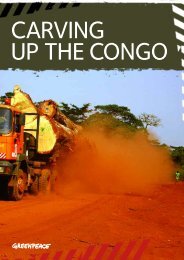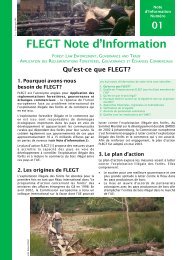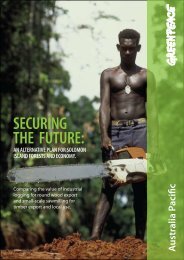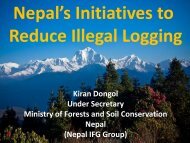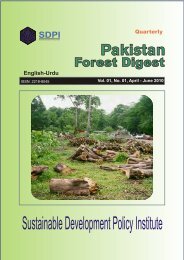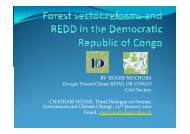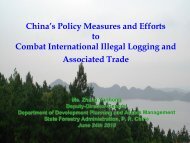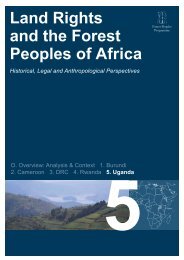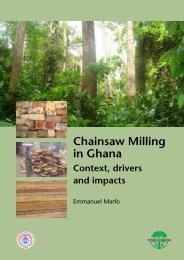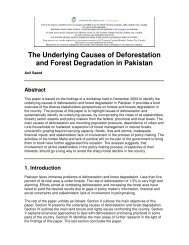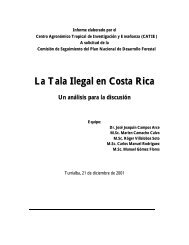difficult to achieve positive conserv<strong>at</strong>ion outcomes. It is not known if <strong>the</strong> Maoists have a specific agenda withrespect to PAs. Individual commanders may simply make use of <strong>the</strong>m as refuges and sources of revenue.Reduced security <strong>in</strong>side protected areas has provided opportunities for wildlife poachers and illegal loggers as<strong>the</strong> result of <strong>the</strong> RNA’s reduced ability to p<strong>at</strong>rol protected areas s<strong>in</strong>ce <strong>the</strong>y began fight<strong>in</strong>g <strong>the</strong> Maoists <strong>in</strong> l<strong>at</strong>e2001. As a result, <strong>the</strong> number of rh<strong>in</strong>os <strong>in</strong> and around Royal Chitwan N<strong>at</strong>ional Park has decl<strong>in</strong>ed by 32%<strong>over</strong> five years (2000-2005) after decades of successful conserv<strong>at</strong>ion. It is not known if <strong>the</strong> Maoists encouragepoach<strong>in</strong>g or “tax” <strong>the</strong> poachers. Maoist control <strong>over</strong> much of <strong>the</strong> countryside is believed to have allowedwildlife smugglers to <strong>in</strong>crease traffic to Tibet <strong>in</strong> parts of tigers, leopards, rh<strong>in</strong>os, and o<strong>the</strong>r species fromanimals poached <strong>in</strong> Nepal and India. It is believed, but not known, th<strong>at</strong> Maoist units protect and tax thistrade.HOW IS NATURAL RESOURCE CONFLICT RELATED TO THE INSURGENCY?Maoist use of <strong>n<strong>at</strong>ural</strong> <strong>resources</strong> to fund <strong>the</strong>ir military oper<strong>at</strong>ions seems to vary widely <strong>in</strong> different parts of <strong>the</strong>country and <strong>over</strong> time. They have shown <strong>the</strong>mselves to be opportunistic, obta<strong>in</strong><strong>in</strong>g funds from wh<strong>at</strong>eversources are <strong>at</strong> hand. Early <strong>in</strong> <strong>the</strong> <strong>in</strong>surgency, <strong>the</strong>y robbed banks to get cash. Over <strong>the</strong> past decade <strong>the</strong>y haveset up systems for levy<strong>in</strong>g taxes on salaries and extort<strong>in</strong>g money from bus<strong>in</strong>esses. We do not know wh<strong>at</strong>percentage of <strong>the</strong>ir total fund<strong>in</strong>g comes from <strong>the</strong> various ways of “tax<strong>in</strong>g” <strong>n<strong>at</strong>ural</strong> resource use. For someMaoist units, especially those <strong>in</strong> <strong>the</strong> high mounta<strong>in</strong>s and along <strong>the</strong> border with India, taxes on NTFPsand timber, respectively, may provide a significant portion of <strong>the</strong>ir fund<strong>in</strong>g.Competition <strong>over</strong> <strong>n<strong>at</strong>ural</strong> <strong>resources</strong> <strong>at</strong> <strong>the</strong> <strong>community</strong> <strong>level</strong> is deeply embedded <strong>in</strong> Nepalese history andsociety. Result<strong>in</strong>g <strong>conflict</strong> was chronic but not violent. The Maoists and <strong>the</strong>ir war with <strong>the</strong> RNA has changed<strong>the</strong> social and g<strong>over</strong>nance framework with<strong>in</strong> which <strong>n<strong>at</strong>ural</strong> resource <strong>conflict</strong> occurs <strong>in</strong> ways th<strong>at</strong> can be bad,good, or neutral for <strong>the</strong> poorest users and <strong>the</strong> <strong>resources</strong> <strong>the</strong>mselves. Competitive <strong>n<strong>at</strong>ural</strong> resource <strong>conflict</strong>cont<strong>in</strong>ues to be largely non-violent dur<strong>in</strong>g <strong>the</strong> <strong>in</strong>surgency, except <strong>in</strong> cases where <strong>the</strong> Maoists have killedforestry and park guards or both sides have killed <strong>in</strong>nocent Nepalese for enter<strong>in</strong>g forested areas.N<strong>at</strong>ural <strong>resources</strong> are l<strong>in</strong>ked to <strong>the</strong> armed <strong>conflict</strong> between HMGN and <strong>the</strong> Maoist <strong>in</strong>surgency <strong>in</strong> five ways:1. Underly<strong>in</strong>g Cause: Resentment <strong>over</strong> discrim<strong>in</strong><strong>at</strong>ory <strong>n<strong>at</strong>ural</strong> resource access is one of <strong>the</strong> underly<strong>in</strong>gpolitical causes of <strong>the</strong> <strong>in</strong>surgency, help<strong>in</strong>g to <strong>at</strong>tract recruits to <strong>the</strong> Maoist cause <strong>in</strong> <strong>the</strong> early stages of <strong>the</strong>irupris<strong>in</strong>g.2. Fund<strong>in</strong>g Source: Maoist military oper<strong>at</strong>ions are partially funded <strong>in</strong> some areas by “taxes” on <strong>n<strong>at</strong>ural</strong><strong>resources</strong>, <strong>in</strong>clud<strong>in</strong>g timber, NTFPs, medic<strong>in</strong>al and arom<strong>at</strong>ic plants, crops from irrig<strong>at</strong>ed land, and n<strong>at</strong>ionalpark visitor fees.3. Refuge: Forests provide bases of oper<strong>at</strong>ion and refuge for Maoist forces and both sides restrict access byrural people to forest areas. The RNA clears forests for hundreds of meters around <strong>the</strong>ir posts to preventsurprise <strong>at</strong>tacks.4. Altered Dynamic of N<strong>at</strong>ural Resource Use and Conflict <strong>at</strong> User Group and Community Level: The<strong>in</strong>surgency has disrupted management of, and <strong>conflict</strong> <strong>over</strong>, forest <strong>resources</strong> and irrig<strong>at</strong>ion w<strong>at</strong>er <strong>at</strong> <strong>the</strong>user group <strong>level</strong> by remov<strong>in</strong>g g<strong>over</strong>nment <strong>over</strong>sight and support, cre<strong>at</strong><strong>in</strong>g an <strong>at</strong>mosphere of <strong>in</strong>security anddistrust, and replac<strong>in</strong>g <strong>the</strong> g<strong>over</strong>nment’s legal framework with Maoist management dict<strong>at</strong>es. This altereddynamic adds to <strong>the</strong> complexity of widespread and chronic <strong>conflict</strong>s and disputes <strong>over</strong> forest and w<strong>at</strong>er<strong>resources</strong> <strong>at</strong> <strong>the</strong> <strong>community</strong> and user group <strong>level</strong>s.5. Forest Management and Biodiversity Conserv<strong>at</strong>ion Disruption: The g<strong>over</strong>nment’s ability to enforceforest management laws and protect wildlife and o<strong>the</strong>r biodiversity <strong>resources</strong> with<strong>in</strong> and outside PAs hasbeen gre<strong>at</strong>ly reduced as a result of <strong>the</strong> armed <strong>conflict</strong>, putt<strong>in</strong>g <strong>the</strong>se <strong>resources</strong> <strong>at</strong> risk. This managementvacuum has led to acceler<strong>at</strong>ed forest degrad<strong>at</strong>ion <strong>in</strong> <strong>the</strong> Terai and <strong>in</strong>creased poach<strong>in</strong>g of some wildlifespecies.viii CONFLICT OVER NATURAL RESOURCES AT THE COMMUNITY LEVEL IN NEPAL
MANAGING NATURAL RESOURCE CONFLICT IN NEPALBy tradition and law, Nepal has a range of formal and non-formal methods to manage or resolve <strong>conflict</strong>.Traditional <strong>conflict</strong> resolution methods have been weakened by distrust among <strong>community</strong> members th<strong>at</strong>developed as communities fractured along political party l<strong>in</strong>es dur<strong>in</strong>g <strong>the</strong> 1990s. In those years, people soughtto settle disputes by align<strong>in</strong>g <strong>the</strong>mselves with a political party, r<strong>at</strong>her than rely<strong>in</strong>g on traditional disputeresolution mechanisms. The <strong>in</strong>security and mistrust cre<strong>at</strong>ed by <strong>the</strong> Maoist <strong>in</strong>surgency has made it difficult, ifnot impossible, for rural people to access formal g<strong>over</strong>nment-sponsored dispute resolution mechanisms.If <strong>the</strong> <strong>in</strong>surgency cre<strong>at</strong>es a social and political transform<strong>at</strong>ion, a major driv<strong>in</strong>g force beh<strong>in</strong>d <strong>n<strong>at</strong>ural</strong><strong>resources</strong> <strong>conflict</strong> would be removed, mak<strong>in</strong>g way for <strong>the</strong> evolution of new <strong>conflict</strong> managementmechanisms. If, however, <strong>the</strong>re is a return to <strong>the</strong> st<strong>at</strong>us quo, but with <strong>the</strong> traditional mechanismsrendered <strong>in</strong>effective, escal<strong>at</strong><strong>in</strong>g <strong>conflict</strong> <strong>over</strong> <strong>n<strong>at</strong>ural</strong> <strong>resources</strong> could help push <strong>the</strong> country backtoward ano<strong>the</strong>r cycle of armed violence.LAYING THE GROUNDWORK FOR THE END OF ARMED CONFLICT ANDREESTABLISHING DEMOCRACY: USAID NEPAL PROGRAMMING OPTIONSA view commonly expressed by <strong>in</strong>terviewees dur<strong>in</strong>g this assessment, and affirmed by <strong>the</strong> authors of several of<strong>the</strong> documents we consulted, is th<strong>at</strong> end<strong>in</strong>g <strong>the</strong> Maoist <strong>in</strong>surgency and reestablish<strong>in</strong>g a workable form ofdemocracy will require tak<strong>in</strong>g mean<strong>in</strong>gful steps to address <strong>in</strong>stitutionalized social discrim<strong>in</strong><strong>at</strong>ion and controlrampant corruption <strong>in</strong> <strong>the</strong> g<strong>over</strong>nment (which reflects and re<strong>in</strong>forces <strong>the</strong> system of social discrim<strong>in</strong><strong>at</strong>ion).Simply re<strong>in</strong>stitut<strong>in</strong>g democracy without chang<strong>in</strong>g underly<strong>in</strong>g <strong>at</strong>titudes, reflected <strong>in</strong> <strong>the</strong> way th<strong>at</strong> <strong>the</strong> politicalparties oper<strong>at</strong>ed <strong>in</strong> <strong>the</strong> past, will not be effective. No one we talked with offered a plan for achiev<strong>in</strong>g thissocial and political transform<strong>at</strong>ion, but most felt th<strong>at</strong> change <strong>in</strong> rural villages is a good place to start, given <strong>the</strong>current political impasse <strong>at</strong> <strong>the</strong> n<strong>at</strong>ional <strong>level</strong>. Maoist de facto control of most rural areas presents a seriousobstacle to outside <strong>in</strong>tervention <strong>at</strong> <strong>the</strong> village <strong>level</strong>, mak<strong>in</strong>g it difficult to offer political or developmentaltern<strong>at</strong>ives.With Village Development Committees (VDCs) and District Development Councils (DDCs) disbanded, <strong>n<strong>at</strong>ural</strong>resource user groups are <strong>the</strong> only democr<strong>at</strong>ically elected <strong>in</strong>stitutions th<strong>at</strong> cont<strong>in</strong>ue to oper<strong>at</strong>e <strong>in</strong> rural areas.G<strong>over</strong>nment officials are largelyprevented from travel<strong>in</strong>g outsidedistrict capitals, so <strong>the</strong>re is virtuallyno g<strong>over</strong>nment presence <strong>in</strong> mostrural areas. While <strong>the</strong> majority ofIWUAs and CFUGs suffer fromdom<strong>in</strong><strong>at</strong>ion by <strong>the</strong> sociallyempowered, <strong>the</strong>se <strong>in</strong>stitutionsrema<strong>in</strong> <strong>the</strong> most promis<strong>in</strong>g meansto improve <strong>the</strong> livelihoods of <strong>the</strong>poor, to demonstr<strong>at</strong>e <strong>the</strong> pr<strong>in</strong>cipleof equal access to <strong>resources</strong>, andto develop a grassrootsunderstand<strong>in</strong>g of democracy uponwhich to rebuild democr<strong>at</strong>ic<strong>in</strong>stitutions <strong>in</strong> <strong>the</strong> country.PRALAD YONZON, ARD, Inc.The programm<strong>in</strong>g options th<strong>at</strong> wepropose below fall under <strong>the</strong>c<strong>at</strong>egory of Conflict-SensitiveDevelopment <strong>in</strong> <strong>the</strong> USAID ConflictMitig<strong>at</strong>ion and Management PolicyA User Group convenes a general assembly for rule form<strong>at</strong>ion.CONFLICT OVER NATURAL RESOURCES AT THE COMMUNITY LEVEL IN NEPALix




